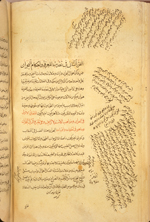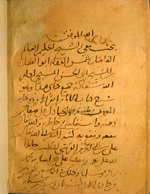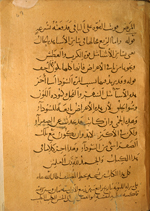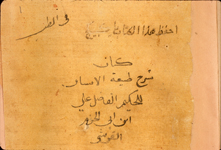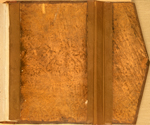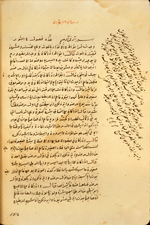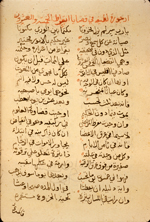Catalogue: Translations of Earlier Sources
Hippocratic Writings Galen Alexandrian Summaries
Commentaries on Hippocratic Treatises
-
 Sharḥ Kitāb Taqdimat al-ma‘rifah
(MS A 27)
Sharḥ Kitāb Taqdimat al-ma‘rifah
(MS A 27) - (A Commentary on the Prognostics)
- شرح كتاب تقدمة المعرفة
- by ‘Alā’ al-Dīn ‘Alī ibn Abī Ibn al-Nafīs (d. 1288/678H)
- علاء الدين على ابن ابى الحزم القرشى المروف بابن النفيس
The Arabic translation of the treatise on prognostics, composed of three chapters, was one of the most influential of the Hippocratic writings in the Islamic world. It was translated from Greek into Arabic by Ḥunayn ibn Isḥāq, and a number of commentaries were composed on the treatise, including one by the thirteenth-century Syrian physician Ibn al-Nafīs. The Arabic translation of the Hippocratic treatise is preserved today in many copies; see Ullmann, Medizin, p. 29; Sezgin GAS III, p. 32 no. 3.
In the NLM collection, lengthy quotations from Ibn al-Nafīs's commentary are preserved, and these occur in the margins of an unidentified treatise on prognostics, whose title, Fī taqdimat al-ma‘rifah wa-ahkām al-burhān (On Prognosis and the Determination of the Crisis), is reminiscent of the Hippocratic treatise on prognostics. From the structure and contents of this unidentified treatise, however, it is evident that it is not the Hippocratic treatise on prognostics known in Arabic as Kitāb Taqdimat al-ma‘rifah.
For complete copies of the commentary by Ibn al-Nafīs, see Ullmann, Medizin, p. 173 no. 3; Sezgin GAS III p. 33 no. 3.d; and Savage-Smith, "Bodleian", MS Marsh 81.
Fī taqdimat al-ma‘rifah wa-ahkām al-burhān (MS A 27 item 4)
Illustrations
The opening of the second section (fann) of an unidentifed treatise on prognostics, with extensive marginal quotations from the commentary by Ibn al-Nafīs on the Hippocratic treatise on prognostics.
Physical Description
Arabic. 35 leaves (fols. 41b-75a). Dimensions 24 x 13.6; text area 16.3 x 6.8 cm; 19 lines per page. The title is given on fol. 41b, line 2. Quotations from the commentary by Ibn al-Nafīs, here referred to as Qurashi, are in the margins of the treatise occupying fols. 41b-75a. The treatise written at the center of the pages is on prognostics, but its author is unidentified; the title of the central treatise is given on fol. 41b, line 2, as Fī taqdimat al-ma‘rifah wa-ahkām al-burhān. According to the heading on fol. 41b, this copy contains only the second part (fann) of the unidentified treatise; this fann is then subdivided into chapters (maqalahs). Space has been left for an illuminated heading, which was not filled in.
The text was copied by the same scribe as recorded the first and third items in the volume. The first item in the volume was completed on 5 Rajab 992 [= 13 July 1584] by an unnamed scribe.
The central text is written in a medium-small, compact, elegant and professional naskh script. Black ink with headings in red and red overlinings. The text area has been frame-ruled. There are catchwords. The marginal annotations containing extracts from the commentary by Ibn al-Nafīs appear to be by the same copyist.
The burnished, glossy beige paper has lightly scattered fibers, vertical slightly curved laid lines, and faint single chain lines (but no watermarks). The paper is water damaged and stained with thumbing and grease. The edges have been trimmed from their original size, and some of the marginal commentaries have been cut off.
For a fuller discription of the volume, see MS A 27 item 1.
Binding
Bound in brown leather library binding; modern paper pastedowns and endpapers.
Provenance
On fol. 40b there is a note stating that the owner (malik) is Isḥāq, a physician in Damascus (tabib fi Damashq al-sham) in the year 1240 [= 1824-5]. On fol. 77a there are various owners' notations, including the statement that this volume is the Kanz al-atibba' (The Treasure of Physicians) belonging to al-faqir Isḥāq the physician (al-tabib) in the year 1251 [= 1835-6] and another statement that this Kanz al-atibba' belonged to one of the skilled wound-healers (ahad min al-hudhdhaq al-sabur) Isḥāq Dhilṭā al-Yahūdī, medical practitioner in Damascus (al-mutatabbib fi Dimashq al-Sham); this is presumably the same owner. His assistant (‘abd) is named, on both fol. 77a and in yet another signature on fol. 38a, as Ibraham Rumanu tabib. On fol. 1a the title Kanz al-atibba' is repeated. On the basis of these owners' notes, Sommer incorrectly catalogued this manuscript as a copy of a treatise titled Kanz al-atibba' written by Malik Iskaq, a Jewish physician of Damascus (see Schullian/Sommer, Cat. of incun. MSS., p. 306 entry A 27).
The volume was purchased in 1941 by the Army Medical Library from A. S. Yahuda who acquired it in Cairo. NLM MS A 23 was acquired in Cairo in the same lot. On the front endpaper several earlier labels have been pasted, including one giving the designation "ELS 1665" and two smaller ones "M[ed.] 44", which are annotations usually found in most manuscripts that were at one time in the collection of A.S. Yahuda.
References
Schullian/Sommer, Cat. of incun. & MSS., p. 306 entry A27 [this item is omitted and the manuscript is incorrectly catalogued]; Hamarneh, "NLM" p. 82 where this item is numbered third in the volume.
NLM Microfilm Reel: FILM 48-117 no. 3
-
 Sharḥ Kitāb Ṭabi‘at al-insān li-Buqrāṭ (MS A 69)
Sharḥ Kitāb Ṭabi‘at al-insān li-Buqrāṭ (MS A 69) - (A Commentary on the Hippocratic Treatise On the Nature of Man)
- شرح كتاب طبيعة الانسان لبقراط
- by ‘Alā’ al-Dīn ‘Alī ibn Abī al-ḥazm al-Qurashī Ibn al-Nafīs (d. 1288/678 H)
- علاء الدين على ابن ابى الحزم القرشى المروف بابن النفيس
The Syrian physician Ibn al-Nafīs, known to his contemporaries by his nisbah al-Qurashī, was educated in Damascus but spent much of his working life in Cairo, where he became "Chief of Physicians". His commentary on the Hippocratic treatise On the Nature of Man is preserved in only one unique copy, now at NLM. The manuscript is important not only because it is the only recorded copy of his treatise, but also because the manuscript contains a signed statement by Ibn al-Nafīs certifying that a student of his, a Christian named Shams al-Dawlah Abū al-Faḍl ibn Abī al-Ḥasan al-Masīḥī, had successfully read and mastered the treatise. The certificate occurs at the end of the manuscript in the handwriting of Ibn al-Nafīs himself, and reads as follows:
[In the name of] God the Provider of Good Fortune: The wise, the learned, the excellent shaykh Shams al-Dawlah Abū al-Faḍl ibn Abī al-Ḥasan al-Masīḥī, may God make his good fortune long lasting, studied with me this entire book of mine -- that is, the commentary on the book by the imam Hippocrates, which is to say his book known as On the Nature of Man -- by which he [the student] demonstrated the clarity of his intellect and the correctness of his thought, may God grant him benefit and may he make use of it. Certified by the poor in need of God, ‘Alī ibn Abī al-ḥazm al-Qurashī [known as Ibn al-Nafīs] the physician. Praise be to God for his perfection and prayers for the best of His prophets, Muḥammad, and his family. And that is on the twenty-ninth of Jumadá I [in the] year six hundred and sixty eight [= AD 25 January 1270].
Such examples of the certified completion of a reading course, often termed an ijazah, are important for the history of medical education in medieval Islam. They are not, however, equivalent to the licensing of physicians upon completion of an approved period of training. Present available evidence suggests that most medical education was obtained by apprenticeship to individual physicians who often, if not usually, had a student study with him a particular medical treatise (often reading aloud the text).
No copy other than the NLM copy is recorded of Ibn al-Nafis's commentary on the Hippocratic treatise On the Nature of Man. Of the Hippocratic treatise itself, two copies of the Arabic translation are preserved today, one in Istanbul and one in Florence, both of which were edited and translated into English by J.N. Mattock and M.C. Lyons, Kitāb Buqrāt fī tabi‘at al-insān (Hippocrates: On the Nature of Man), (Arabic Technical and Scientific Texts, vol. 4), Cambridge: Cambridge Middle East Centre, 1968.
Sharḥ Kitāb Ṭabi‘at al-insān li-Buqrāṭ (MS A 69)
Illustrations
Certification in the handwriting of Ibn al-Nafīs that a student successfully read and demonstrated his proficiency with the text. The student, Shams al-Dawlah Abū al-Faḍl ibn Abī al-Ḥasan al-Masīḥī, a Christian physician, was also the copyist of the treatise.
The colophon, where it is stated that the copy was made by the physician Abū al-Faḍl ibn Abī al-Ḥasan from an autograph copy in the hand of the author, Ibn al-Nafīs. The copyist was also Ibn al-Nafīs' pupil, as is evident in the certificate on the reverse side of the folio, where the copyist's name is given in a fuller form.
The title page, with a talismanic inscription at the top, added by a later owner, reading uhfuz hadha al-kitab ya kabikaj ("protect this book, O buttercup"), a reference to the magical and protective powers associated with the buttercup (a variety of Ranunculus) that was considered especially effective against worms and insects which were prone to attack old manuscripts.
Physical Description
Arabic. 67 folios. Dimensions 17.6 x 12.7 cm; text area 14.1 x 8.5 cm; 13 lines per page. The title is given as Sharḥ tab‘iat al-insan on the title page (fol. 1a)and again at the beginning of the treatise (fol. 1b, lines 7-8) and in the certificate written by Ibn al-Nafīs at the end of the volume (fol. 67b). The author of the commentary, ‘Alī ibn Abī al-ḥazm al-Qurashī [Ibn al-Nafīs] is named on fol. 1b, line 6, on the title page (fol. 1a, illus 3), and the certificate at the end of the volume (fol. 67b). Hippocrates is stated to be the author of the Greek original on fol. 1b, line 7 and in the certificate on fol. 67b, line 6).
According to the colophon on fol. 67a (illus 2), the copy was completed on 4 Rab‘i I 668 (= 1 November 1269) by the physician Abu al-Fadl ibn Abi al-Hasan from an autograph copy in the hand of the author, Ibn al-Nafīs. The copyist was also Ibn al-Nafīs's pupil, as is evident in the certificate on the reverse side of the folio (fol. 67b, illus 1), where it is certified by Ibn al-Nafīs himself that his pupil, Shams al-Dawlah Abū al-Faḍl ibn Abī al-Ḥasan al-Masīḥī, completed his study of the volume on 29 Jumadá I 668 (=25 January 1270).
No other copy of the treatise is recorded.
The text is written in a medium large naskh script without full diacritical dots but with some vocalization. Black ink with headings in red. There are no catchwords. The lightly glossed paper has been dyed a pink-brown; it has vertical laid lines and chain lines in groups of 3's. The 10-leaf quires were at one time numbered, though most of the labels have now been lost in the trimming of the paper. Some folios are damaged and have been repaired; the edges have been trimmed so that a few words in the margins are cut off. Fol. 1 is a slightly later replacement, with different paper and written in a different hand. There are marginal corrections and other marginalia.
On the title page (fol. 1a) there is a talismanic inscription at the top, added by a later owner, reading uhfuz hadha al-kitab ya kabikaj (protect this book, O buttercup). This is a reference to the magical and protective powers associated with the buttercup (a variety of Ranunculus) that was considered especially effective against worms and insects which were prone to attack old manuscripts.
Binding
The binding is brown leather over pasteboards, with the covers and envelope flap decorated with gilt-tooled central medallions and gilt borders. There are doublures of block-pressed leather. The endpapers are modern. The binding is not original to the manuscript.
Provenance
The volume was purchased in 1941 by the Army Medical Library from A. S. Yahuda, who apparently acquired it in 1933 from the private library of Aḥmad ‘Ubayd in Damascus (see A.Z. Iskandar, DNB, vol. 9, p. 603). According to A.S. Yahuda's notes, he assigned the manuscript the number ELS No. 3543, though this number does not now appear in the volume. The volume does contain a label with the number 260.
References
Schullian/Sommer, Cat. in incun. & MSS., p. 320 entry A69; Hamarneh, "NLM", p. 78.
NLM Microfilm Reel: FILM 48-126 no. 2
Spurious Hippocratic Writings
-
 Kitāb al-Buthūr
(MS A 84, item 2)
Kitāb al-Buthūr
(MS A 84, item 2)
- (The Book of Pustules)
- كتاب البثور
- falsely ascribed to Hippocrates
- بقراط ابقراط
This treatise is an Arabic translation of a Greek compilation concerned with prognosis and the signs of death based on skin disorders. Twenty-five examples (qadiyahs) of skin conditions indicating impending death are given. Written in the 4th or 5th century A.D. in Alexandria and spuriously attributed to Hippocrates, it was said to have been found in his tomb. A story was usually recounted in which it was said that Hippocrates, when he knew he was about to die, instructed that the treatise be placed in an ivory case and buried with him. Caesar himself (or some unnamed Byzantine ruler) was said to have had the case removed from his tomb and the treatise copied and made known. The legend that the treatise on prognostics by skin disorders was found in Hippocrates's tomb in an ivory casket accounts for the common Latin title Capsula eburnea. For variants of the name of the discoverer of this prognostic manual in Hippocrates's tomb, see Rosa Kuhne Brabant, "The Arabic Prototype of the 'Capsula eburnea'," Quaderni di Studi Arabi [Atti del XIII Congresso dell'Union Européenne d'Arabisants et d'Islamisants, Venezia 29 Settembre-4 Ottobre 1986], vols. 5-6 (1987-8), pp. 431-441, esp. pp. 435-346.
The treatise was translated into Arabic by Yahya ibn al-Bitriq (d. ca 815/200 H) and circulated under several different titles, including Risālah fī al-Qadaya, Risālah fī ‘Alamat al-mawt, Risālah al-qabryah, Qadaya al-Ibuqratiyah al-dallah ‘alá al-mawt, and Kitāb al-sirr (The Book of Secrets). Its Latin translation also went under several titles, including Secreta Hippocratis, Capsula eburnea, De pustulis et apostematibus significantibus mortem, and De indiciis mortis.
This must have been a very popular treatise, for numerous copies are preserved today in various libraries. For an edition, with Spanish translation, of the treatise, see Rosa Kuhne, "El Kitaā al-Dury, prototipo árabe de la Capsula Eburnea y representante más genuino de la tradición de los Secreta Hippocratis," Al-Qantara, vol. 10 (1989), p. 3-20 and 299-327, and vol. 11 (1990), p. 3-58. Twenty-five copies of the treatise were used in making this critical edition of the treatise; the NLM copy was one of the versions employed in the edition. For other copies, see Ullmann, Medizin, p. 33-34 no. 29, and Sezgin, GAS III, p. 39-40 no. 13 and p. 411; and Savage-Smith, "Bodleian", MSS Marsh 537 and Hunt. donat. 18.
Kitāb al-Buthūr (MS A 84, item 2)
Illustrations
The opening of the treatise, spuriously attributed to Hippocrates, on pustules and the signs of impending death. The note added in the margin states that this treatise was found in the tomb of Hippocrates.
Physical Description
Arabic. 3 leaves (fols. 39b-41a, line 1). Dimensions 20.8 x 14.5; text area 14.2 x 7.5 cm; 23 lines per page. The author is identified as Hippocrates at the top of the opening page and in the margin of fol. 39b, where the translation (tafsir) is said to be that of Yahya ibn al-Bitriq. For variations on the translator's name in other copies, see Rosa Kuhne Brabant, "The Arabic Prototype of the 'Capsula eburnea'," Quaderni di Studi Arabi [Atti del XIII Congresso dell'Union Européenne d'Arabisants et d'Islamisants, Venezia 29 Settembre-4 Ottobre 1986], vols. 5-6 (1987-8), p. 431-441. The title Fī al-buthūr (On pustules) and a second title, Fī al-indhar bi-al-mawt (On the Warning of Death) are given on fol. 39b, lines 1-2.
The treatise was copied by the same copyist who transcribed the other four items in the volume. In the colophon to the first item (fol. 39a) it is stated that the transcription (naql) was completed at the beginning (fi ibtida') of the month of Sha‘ban 971 [ = March 1564] by a scribe named Mas‘ūd ibn Mas‘ūd ibn ‘Alī known as (mulaqqab bi-) Kamāl al-Dīn al-Kirmānī.
The text is written in a small compact naskh, with some ligatures. Black ink with headings in red and red overlinings. There are catchwords. The leaves have been frame-ruled, and sometimes the final letters of a word at the end of a line are written at a distance outside the ruling line.
The beige lightly-glossed paper has single chain lines and watermarks. The paper is waterstained, and the edges have been trimmed from their orignal size.
The volume consists of 59 leaves. fols. 1a-39a (MS A 84, item 1) contain a medical compendium by Mas‘ūd ibn Muḥammad al-Sijzī; fols. 41a-44a (MS A 84, item 2) have a synopsis of a treatise by Galen here catalogued; fols. 44b-46a (MS A 84, item 3) a tract by Rāzī ; and fols. 46a-59b (MS A 84, item 4) an anonymous medical manual and an anonymous medical guide (MS A 84, item 5). All the items are copied by the same copyist.
Binding
The volume is bound in a modern library binding of brown leather over boards. Modern pastedowns and endpapers.
Provenance
The volume was purchased in 1941 by the Army Medical Library from A.S. Yahuda (ELS No. 1708; Med. 19).
References
Schullian/Sommer, Cat. of incun. & MSS, p. 325 entry A 84 item 2; Hamarneh, "NLM", p. 78.
NLM Microfilm Reel: FILM 48-17 no. 4
-
 Urjūzah laṭīfah fī Qaḍāyā Ibqarāṭ al‑khamsah wa‑al‑‘ishrūn
(MS A 34, item 8)
Urjūzah laṭīfah fī Qaḍāyā Ibqarāṭ al‑khamsah wa‑al‑‘ishrūn
(MS A 34, item 8) - (An Elegant Poem on the Twenty-five Premises of Hippocrates)
- ارجوزة لطيفه فى قضايا ابقراط الخمسه والعشرون
- ascribed to Hippocrates بقراط ابقراط, with the versification sometimes ascribed to Ibn Sīnā (Avicenna)
- ابو على
A didactic poem summarizing the previous treatise (Kitāb al-Buthur). The earlier prose treatise being here versified was written in the 4th or 5th century in Alexandria and spuriously attributed to Hippocrates. In many of the manuscript copies of this poem, the versification is attributed to Ibn Sīnā (Avicenna), and occasionally to Shams al-Dīn ibn Makkī.
There is a two-line heading, that occurs in an Oxford manuscript (Bodleian Library, Oriental Collections, MS Marsh 537 item 4), missing in the other recorded copies, that reads as follows: "This is what was found on top of Hippocrates the physician when the ruler Uqlis exhumed him and removed it from his coffin. And we have put it into verse in order to make its memorization easy for whomever desires it."
An edition and study of the poem has been published by B. [Rosa] Kuhne, "La Uryuza latifa fi qadaya Ibuqrat al-jams wa-l-‘isrin de Avicenna," p. 343-366 of volume 2 of Homenaje al Prof. Darío Cabanelas Rodríguez, O.M.F., con motivo de su lxx aniversario (Granada: Universidad de Granada, Departamento de Estudios Semíticos, 1987). For other copies of the poem, see Ullmann, Medizin, p. 155; Sezgin, GAS III, pp/ 39-40 no. 13; and Jules L. Janssens, An Annotated Bibliography on Ibn Sina (1970-1989), including Arabic and Persian Publications and Turkish and Russian References, Ancient and Medieval Philosophy [De Wulf-Mansion Centre, ser. 1, vol. XIII] (Leuven: University Press, 1991), p. 56 no. 3.
Urjūzah laṭīfah fī Qaḍāyā Ibqarāṭ al‑khamsah wa‑al‑‘ishrūn (MS A 34, item 8)
Illustrations
The beginning of the poem Urjūzah laṭīfah fī Qaḍāyā Ibqarāṭ al‑khamsah wa‑al‑‘ishrūn based on a treatise falsely attributed to Hippocrates, with the versification sometimes attributed to Ibn Sīnā (Avicenna).
Physical Description
Arabic. fol. 60b only. Dimensions 20 x 13.7; text area approx 15.3 x 9 cm; 18 lines per page.
An incomplete copy of the poem, consisting of only the opening page. There is no attribution of the versification to Ibn Sīnā or Ibn Makkī, though the fragment follows three poems by Ibn Makkī. The title is given in the first line of text.
The copy is undated; the general appearance of the script, ink, and paper suggest an 18th-century date. The same scribe copied all the items in the volume.
The text is written in a medium-small naskh, inelegant and awkward but consistent, with some ligatures. The text area has been frame-ruled but the ruling was often not followed. The heading is in red with some vocalization and ends of lines are indicated in red dots. A catchword occurs at the bottom of the page, indicating that the text was to continue on pages now lost.
The cream, semi-glossy paper has laid lines, single chain lines, and is watermarked; it is worm-eaten (some repairs), and the edges have been trimmed from their original size.
Binding
The binding is red leather over pasteboards, with envelope flap; a modern library binding. The endpapers and pastedowns are modern.
Provenance
Purchased in 1941 by the Army Medical Library from A. S. Yahuda (ELS 1709 Med. 70).
References
Schullian/Sommer, Cat. of incun. & MSS., p. 304-305, A34 (this item not described).
NLM Microfilm Reel: FILM 48-119 no. 1

